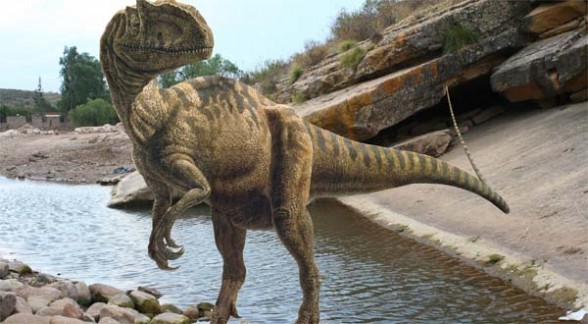Post by dinosauria101 on Jun 14, 2019 16:50:46 GMT 5
Aerosteon riocoloradense
Aerosteon is a genus of tyrannosauroid theropod dinosaur from the Late Cretaceous period of Argentina. Its remains were discovered in 1996 in the Anacleto Formation, dating to the Santonian stage (about 84 million years ago). The type and only known species is A. riocoloradensis. Its specific name indicates that its remains were found 1 km north of the Río Colorado, in the province of Mendoza. They show evidence of a bird-like respiratory system. Aerosteon's name can be translated as air bone and derives from Greek ἀήρ (aer, "air") and οστέον (osteon, "bone"). Aerosteon was a 9 metre (30 ft) long bipedal carnivorous dinosaur that lived approximately 83 million years ago during the Santonian stage. The remains discovered include a single tooth, some cranial bones, a number of partial or complete vertebrae from the neck, back, and sacrum, several cervical and dorsal ribs, gastralia, furcula (wishbone), left scapulocoracoid, left ilium, and left and right pubes. The incomplete fusion of some of its bones indicate that it was not quite fully mature.

Bistahieversor sealeyi
Bistahieversor (meaning "Bistahi destroyer") is a genus of tyrannosauroid dinosaur. Bistahieversor existed around 75 million years ago during the Late Cretaceous. The name Bistahieversor comes from the Navajo Bistahí, or "place of the adobe formations" in reference to the Bisti/De-Na-Zin Wilderness where it was found, and eversor, meaning "destroyer." Material from both adolescent and adult individuals has been found in the Kirtland Formation of New Mexico, United States. Adult Bistahieversor are estimated to have been around 9 metres (30 ft) long, weighing at least a ton. The snout is deep, indicating that the feature is not unique to more derived tyrannosaurs such as Tyrannosaurus. Geographical barriers such as the newly forming Rocky Mountains may have isolated the more southerly Bistahieversor from more derived northern tyrannosaurs.

Credit to Wikipedia
Aerosteon is a genus of tyrannosauroid theropod dinosaur from the Late Cretaceous period of Argentina. Its remains were discovered in 1996 in the Anacleto Formation, dating to the Santonian stage (about 84 million years ago). The type and only known species is A. riocoloradensis. Its specific name indicates that its remains were found 1 km north of the Río Colorado, in the province of Mendoza. They show evidence of a bird-like respiratory system. Aerosteon's name can be translated as air bone and derives from Greek ἀήρ (aer, "air") and οστέον (osteon, "bone"). Aerosteon was a 9 metre (30 ft) long bipedal carnivorous dinosaur that lived approximately 83 million years ago during the Santonian stage. The remains discovered include a single tooth, some cranial bones, a number of partial or complete vertebrae from the neck, back, and sacrum, several cervical and dorsal ribs, gastralia, furcula (wishbone), left scapulocoracoid, left ilium, and left and right pubes. The incomplete fusion of some of its bones indicate that it was not quite fully mature.

Bistahieversor sealeyi
Bistahieversor (meaning "Bistahi destroyer") is a genus of tyrannosauroid dinosaur. Bistahieversor existed around 75 million years ago during the Late Cretaceous. The name Bistahieversor comes from the Navajo Bistahí, or "place of the adobe formations" in reference to the Bisti/De-Na-Zin Wilderness where it was found, and eversor, meaning "destroyer." Material from both adolescent and adult individuals has been found in the Kirtland Formation of New Mexico, United States. Adult Bistahieversor are estimated to have been around 9 metres (30 ft) long, weighing at least a ton. The snout is deep, indicating that the feature is not unique to more derived tyrannosaurs such as Tyrannosaurus. Geographical barriers such as the newly forming Rocky Mountains may have isolated the more southerly Bistahieversor from more derived northern tyrannosaurs.

Credit to Wikipedia


